Acropolis of Athens- the greatest monument of ancient architecture in the Greek city of Athens. The ancient temples of the gods of Hellas were located here. The Acropolis rises above the city, standing on a huge limestone cliff.
In contact with
classmates
View of the Athenian Acropolis (Carole Raddato / flickr.com) Parthenon (Tilemahos Efthimiadis / flickr.com) Athenian Acropolis (© A. Savin, Wikimedia Commons) Acropolis, Propylaea (Dimitris Kamaras / flickr.com) View of the Plaka area from the Temple of Zeus Olympian, Acropolis, Athens, Greece (George Rex / flickr.com) Acropolis - Theater of Dionysus (swifant / flickr.com) Temple of Niki Apteros (Tilemahos Efthimiadis / flickr.com) Temple of Apteros (Tilemahos Efthimiadis / flickr.com) Close-up one of the corners of the Apteros temple at the top of the Acropolis (Jack Zalium / flickr.com) Propylaea (elias filis / flickr.com) Propylaea (piet theisohn / flickr.com) Entrance to the Acropolis (ohhenry415 / flickr.com) View of the Acropolis from the Agora ( Arian Zwegers / flickr.com) Erechtheion (Casey And Sonja / flickr.com) Hecatompedon (Roy L… / flickr.com) Ronny Siegel / flickr.com Erechtheion / Caryatids (George Rex / flickr.com) Odeon of Herodes Atticus, built in 161 AD on the southern slope of the Acropolis in Athens in memory of his wife Annia Regilla, Athens, Greece (Carole Raddato / flickr.com) Parthenon, Acropolis of Athens (Carole Raddato / flickr.com) Parthenon, 1985 (Nathan Hughes Hamilton / flickr .com) In front of the Parthenon (Kristoffer Trolle / flickr.com) Parthenon, Acropolis in Athens (faungg's photos / flickr.com) Parthenon in Athens (Attica, Greece) (© A. Savin, Wikimedia Commons) Schematic of the Acropolis with signatures (© Madmedea , Wikimedia Commons)
And it was after the end of the war with the Persians that the classic period of Greek democracy, which we teach in school, began. He commissioned the construction of the Parthenon from leading architects and artists of the time, in order not only to honor Athena, but also to proclaim the glory of Athens to the whole world. There was already the Temple of Athens to Nike, which is the first temple built on the Acropolis with the Ionic style, and the Propylaeum, which is the entrance gate. Later, Erektion was built, which is a temple that has beautiful columns in female forms, caryatids.
Of course, at the same time another war was fought, this time with Sparta's neighbors. Finally, when the Peloponnesian War ended and Sparta won in 404 BC. This is the same Acropolis that we visited today. All this until the Byzantine Empire and Christianity appear. Emperor Justin did not want to know about paganism in his lands, and he turned the Parthenon and the Renaissance into Orthodox churches. He also closed all schools of philosophy, probably to the utter horror of all Greeks.
The main attractions in Greece are the Athenian Acropolis, Olympia and Rhodes.
The Acropolis is the greatest monument of ancient architecture in the Greek city of Athens. This is a whole complex of structures, which were worked on by ancient masters of sculpture and architects.
The Acropolis of Athens was sacred place, ancient temples of the gods of Hellas were located here. It is sad that now only ruins can be seen here. But even now architectural ensemble The Athenian Acropolis is admired by lovers of antiquity.
Athens became the duchy of the Franks, and the poor Parthenon became a Catholic cathedral - ah, they also made the Propylaea a palace. But the transformations have not stopped. The Parthenon became a mosque. About 200 years later, in the battle with Venice, the Turks were surrounded in Athens and took refuge in the Acropolis. The Parthenon turned its supply of gunpowder.
Unfortunately for all mankind, he was struck by fire and completely destroyed. As if this succession of empires was not enough, two other factors significantly contributed to the destruction of the classical Greek Acropolis. Firstly, after this conflict with Venice, the Turks made this place part of the city. People here not only damaged the buildings with their presence, but also robbed the marble of the temples.
Where is the Acropolis located?
The Acropolis is the heart of Athens and the whole of Greece. It rises above the city, standing on a huge limestone cliff. Its upper platform is small - 300 by 130 meters.
At the top is the majestic Parthenon, the temple of the goddess after whom the capital of Greece is named. He is the main attraction of the Acropolis. It can be seen almost everywhere within the city, and at present it is forbidden to build high-rise buildings in Athens, so as not to overshadow this unique cultural monument.
To make matters worse, the British ambassador used his position of power with the Turkish government to get permission to remove all the pieces of antiquity he wanted. And this is what he has been doing for 20 years. Until now, the Greek and British governments dispute these plays.
Immediately after the formation of the new Hellenic government, the process of restoration and excavation began. Its galleries date back to the results of all periods of the occupation of the Acropolis. It was architectural complex, which for millennia served as a military fortification, political center and religious sanctuary in Athens. It was an architectural complex that served as a military fortification, political center and religious sanctuary in Athens for a thousand years. In addition to the typical Greek architectural styles, Doric and Ionic, the Acropolis also had influences from Egyptian and Persian and Phoenician art.
Next to the Parthenon, you can see the graceful Erechfeion - the temple of three deities: Athena, Poseidon and Erechfey. It was possible to enter the Athenian Acropolis only through the huge gates - the Propylaea.
Acropolis in ancient Greece
Acropolis in Greek means high city... As already mentioned, he stands on an impregnable rock, which, in turn, crowns a hill stretching from west to east. It is surrounded by walls, especially they are high in those places where there is an opportunity to climb the rock.
The works were attended by natives, foreigners and slaves. The slaves earned 1 drachma per day. The same as the architects, who at least had the advantage of receiving directly, without owners. The name "acropolis" refers to the upper part of the ancient cities. One of Athens is located 156 m above the level of the capital.
Temple of Zeus Polia, erected in 500 BC. It was composed only of a sacred wall and an altar for sacrifices and rituals. The Temple of Olympian Zeus is the most large building all over the city. 
The Temple of Athena Nike replaced the earlier one, also dedicated to Athena, which may have been the first building of the Acropolis. The location, next to the entrance ramp, was privileged as it could be seen from the low city.
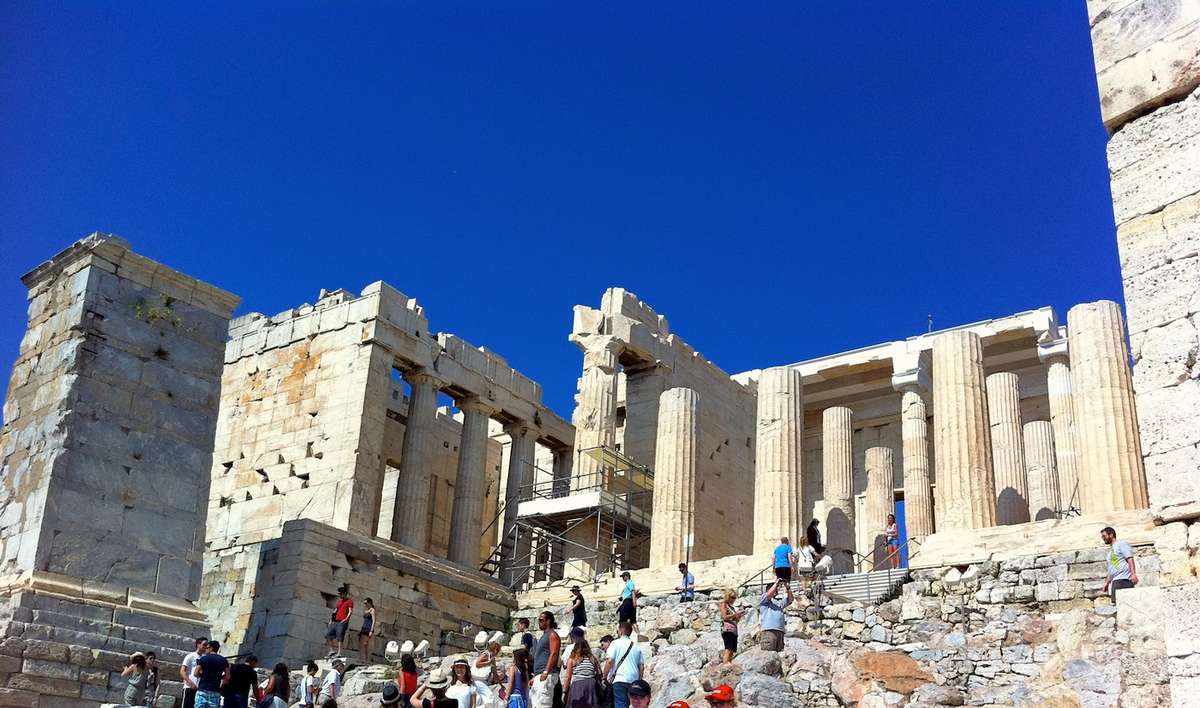 Propylaea (elias filis / flickr.com)
Propylaea (elias filis / flickr.com) In ancient times, the Athenian Acropolis served as a sanctuary and at the same time a refuge of natural origin, protecting the Greeks from enemies.
In 480s BC, the "high city" was under the leadership of King Xerxes.
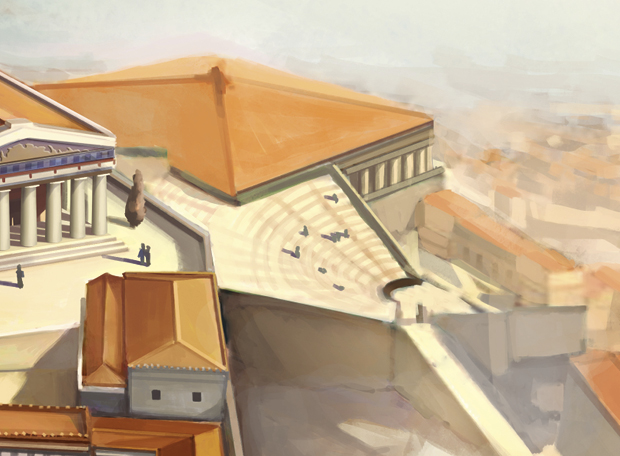
The theater and sanctuary of Dionysus highlighted the performing arts. Located on the southern slope of the Acropolis, it was the most important theater in Athens, home to the works of classical authors such as Sophocles, Euripides and Aeschylus. 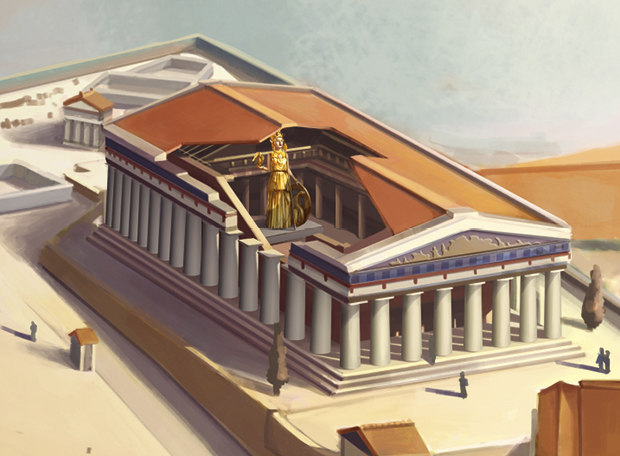
The Parthenon was installed in an unusual way. The axes of the cone of the columns and the platform on which they were erected are slightly curved. The temple had a sanctuary and a pledge in which the city's treasures were kept. When Greece came under the control of the Byzantine Empire, the Parthenon became a church.
They were unable to climb the imposing rock, but were able to penetrate the Athenian Acropolis from the north. There, apparently, there were thickets of bushes, the slope was not guarded, and it was assumed that no one could climb it. However, several Persians were able to get into the Acropolis and the first thing they did was to open the gates.
The invaders took out all the valuables and destroyed many buildings, including the unfinished Parthenon. Arrows found on the northern slope testify to this event. When the Greeks returned to their abode after the Battle of Salamis, they built a wall to protect the north side and, of course, sought to rebuild their sanctuary.
The open courtyard hosted the awards and closing ceremonies of the Panathenaean Games, which was the most important in Athens. They resembled the Olympic Games, combined sports and religious festivals. They ended with a procession to the Acropolis, which was even more prestigious than the games themselves.
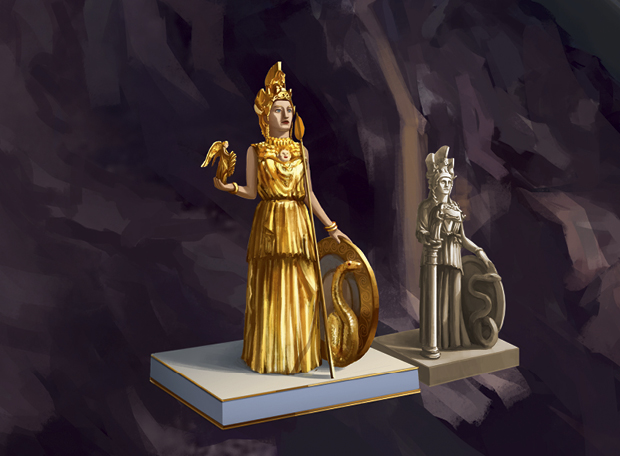
Two statues stood out: Athena Parthenos, in the Parthenon, was 9m high and was built of ivory, metal and wood. On her chest was the head of a medusa, and in one hand was a nearly 2-foot statue of Nike, the goddess of victory. Another was Athena Nike, made of wood. Unlike other performances like the Parthenon, it did not have wings.
Excavations have shown that in the II century BC, religious holidays, meetings of authorities and trials were also held here. And all the social, cultural and religious life of Athens took place in the Acropolis. The oldest buildings on the Acropolis are poorly preserved, in contrast to Olympia and other places of worship in Greece.
Athens is a must for anyone visiting Greece. Even those who, like us, are on Greek islands, as their main target, pass through Athens. At the beginning or end of the trip. Athens is the capital of Greece with about 4 million inhabitants. Until recently, it was a chaotic, polluted city that was difficult to navigate and save only thanks to the historical and archaeological sites it had.
Much has changed in Athens since the reforms, so that the city will host the Olympic Games of wide avenues, the metro system has been noticeably improved, and the city is cleaner and more beautiful. However, the cost of these reforms contributed to the increase in the country's indebtedness and, as a result, to the exacerbation of the current economic crisis faced by Greece.
The most ancient buildings of the Acropolis
From the buildings of the 6th century, only the foundations have survived to this day, due to the war between the Greeks and the Persians. The buildings that were in this period undoubtedly resemble the temples of Apollo at Corinth, Hera at Olympia and Demeter at Paestum.

Their architecture is heavy and harsh. In the VI century BC, the most ancient temple Athens on the Acropolis, which was called. Having passed through the gates of the Propylaea, the man admired his beauty.
The construction is located in the same place where the Athens stadium was in ancient times, where the sports competitions of the Panafenai Games were held. The city is a modern metropolis, cosmopolitan and vibrant nightlife... Theaters, museums and historical places make Athens a cultural enrichment. City life revolves around the historic Plaka district, in the center of the city. There are taverns, restaurants, antique shops and handicrafts.
Near the vicinity of Plaka, the Ancient Agora appears, which was the religious political center of ancient Athens. The main building of the Agora is the Stoa Attalus. The main attraction of Athens is the Acropolis. A collection of temples located in the highest part of the city. The architectural cluster of the Acropolis began to be built by Pericles in the 5th century AD. it is formed by three temples, two theaters and a monumental portico at the entrance.
Ancient masters strove for symmetry, which was present everywhere: in planning, in images. Pediment of Hecatompedon depicted the struggle of Hercules with Triton. And also there was a sculpture of a kind Attic creature, which had three bodies and three heads and was called Tritopator.
He is depicted creeping out of the corner of the pediment. The paint on him was preserved, his body was pink, and his hair and beards were blue. It is noteworthy that one of the heads is kept in the museum and went down in history under the nickname "Bluebeard". The ancient master filled the lower parts of the pediment with writhing serpentine tails.
The Eredes amusement theater, or Odeon, is wonderful. Today it is used for outdoor concerts. It has exceptional acoustics. The biggest attraction of the Acropolis is the Parthenon, a temple dedicated to the Goddess Athena. One of the most famous buildings in the world, was ordered by Pericles, and construction work began in 447. The temple was built to house the Parthenos by the Greek sculptor Phidias. Impressive statue of the goddess Athena, 12 m high, covered with ivory and gold.
The porch of the Caryatids is also part of the entire Acropolis. These are statues of women that act as pillars and form one of the entrance porticoes of Erektion, a temple dedicated to Poseidon, Athena and Erechtheim. Many of the sculptures of the Acropolis and the Parthenon have been destroyed, some, but they can still be admired.
A relief of soft limestone was also found here, depicting the battle of Hercules and the Hydra. The statues of kor. Found here are widely known. Someone claims that these are sculptures of goddesses, someone sees in them girls bringing gifts to Athena. Their clothes are beautiful and festive, complex hairstyles are richly decorated.
Athenian Acropolis during Roman rule
Many buildings arose when Greece became part of the Roman Empire, under Hadrian. The Temple of Zeus and the Acropolis in Athens are separated by an arch, this is the border between the old ancient city and buildings from the times of Rome.
And the pediments, his disciples or his rivals, and who was the author of the famous chriseliphanic statue of the goddess that adorns the lower part of the sanctuary. In front of the current Parthenon in the Acropolis, in the same place, and also in honor of Athena, the protective deity of Athens and Attica, an older temple was erected. Parthenon, Ch.
Loviot, the library of the National School of Fine Arts, provided us with a complete picture of the architecture, sculpture and decoration that made this temple an undeniable masterpiece. Greek art... It is enough to consider the plan of the Parthenon, restored according to the drawings of Packard, and borrowed from the Acropolis of Athens by Beleus, to see that, despite its length and wealth, this temple followed the usual laws. Greek architecture and kept its simplicity. Penrose undoubtedly established and established the curvatures and inclinations of all the lines of this temple, and many still visible traces of paint lead us to admit that the Parthenon was completely covered with a covering like the inner frieze of the porticoes, which depicted the procession of Panatenea, and similar to the methods on which there were scenes of Athenian mythology were carved, the fronts of the temple were covered with sculptures depicting the east, the birth of Athena and the West, the struggle of Athena and Poseidon to preserve the defense of Attica.
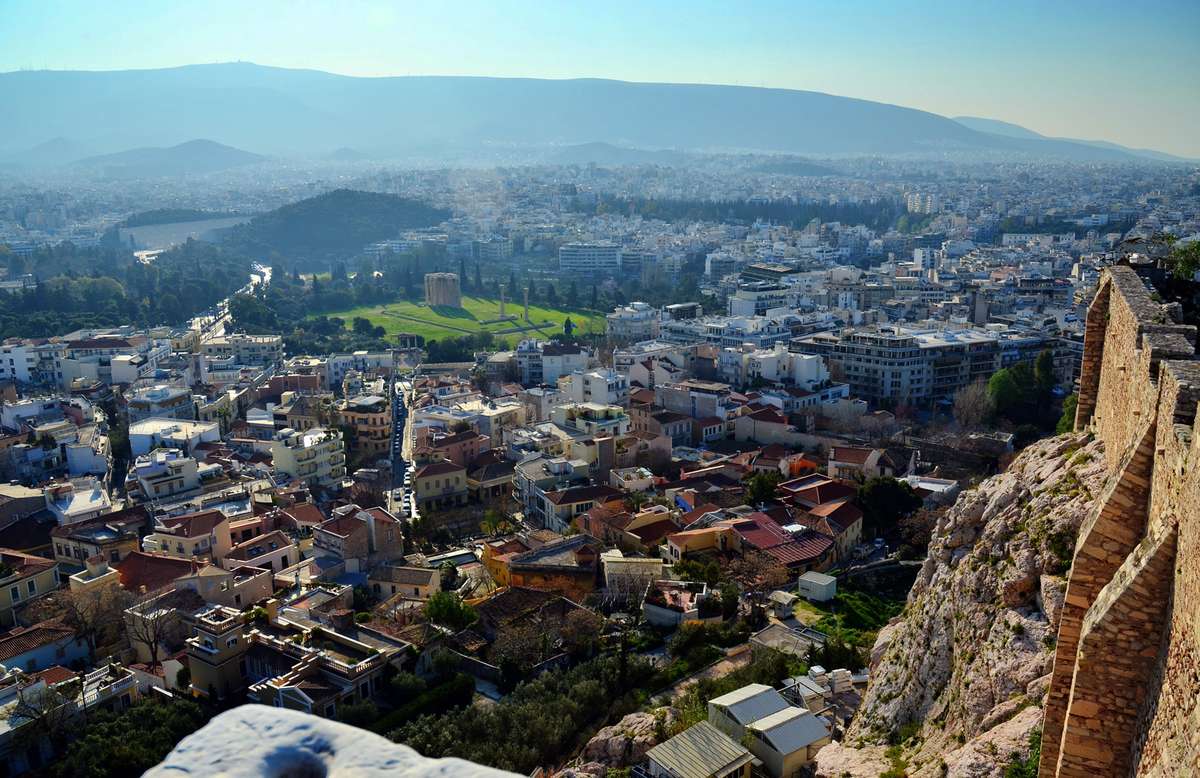 View of the Plaka area from the Temple of Olympian Zeus, Acropolis, Athens, Greece (George Rex / flickr.com)
View of the Plaka area from the Temple of Olympian Zeus, Acropolis, Athens, Greece (George Rex / flickr.com) On the side of the Acropolis, on the arch is written: "This is the city of Theseus." This is due to the heroic legend. Rise of Athens above the rest Greek cities, took place after the fall of the state on the island of Crete.
As for the colossal statue, all the ivory and ivory of the goddess, the most important restitution commissioned for the statue of Sirtam by the Duke de Lunin and preserved in the castle of Dampier, shows Athena leaning on her shield and standing on an ornate pedestal.
The original caryatids were transferred to the Acropolis Museum and replaced with faithful copies of the monument. The monument was completely destroyed, errors in the placement of some blocks were corrected, a copy of the northeast column of the monument and parts of the entablature were transferred to the monument.
This is a must-see for anyone looking to discover the secrets of the Greek capital and its past. A symbol of the city since its legendary, semi-historic creation, this rocky plateau allows visitors to visit many monuments such as the Temple of Athena Nike.
This event happened thanks to Theseus, who defeated the minotaur. With the help of Ariadne's thread, he was able to return, at the same time liberate and glorify the city.
On the other side you can see the inscription: "This is the city of Hadrian." That is, the city of the emperor, under which many buildings were built in Athens. The material was Pontic marble.
Construction was carried out in such a way that the entire complex of buildings looked harmonious, and there was no sudden transition from the rest of the city to the sanctuary. Not far from it is the theater of Dionysus, the market square, other sanctuaries - the Temple of Zeus and the Temple of Hephaestus.
This fisherman's tavern is a unique place where traditional dishes are served: dishes of fish, crustaceans or lamb - already very common in antiquity. 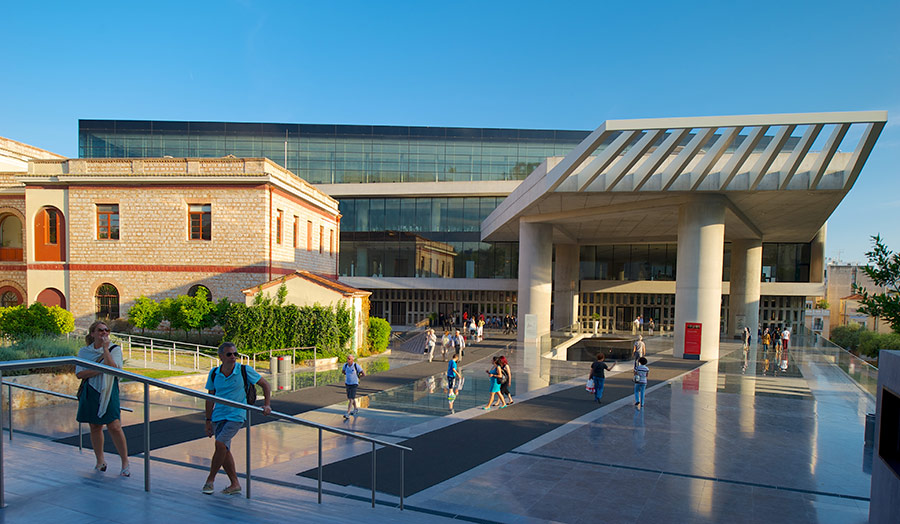
There are over 50 museums in Athens, some of which are among the most beautiful in the world. If you need to make a choice, choose the Acropolis Museum to go back in time. Built on stilts, it reveals the secrets of the Acropolis of Antiquity. Sculpture lovers appreciate the magnificent collection of statues that once adorned the Athenian shrine.
The architectural ensemble of the Athenian Acropolis
The ruins that can be seen in the Acropolis currently belong mainly to such majestic structures as the Propylaea with the Temple of Niki the Wingless, the Parthenon and Erechfeion.
The ensemble of the Athenian Acropolis was truly beautiful in ancient times, if, for example, in Olympia all the temples are similar, then in the Acropolis, each building is unique.
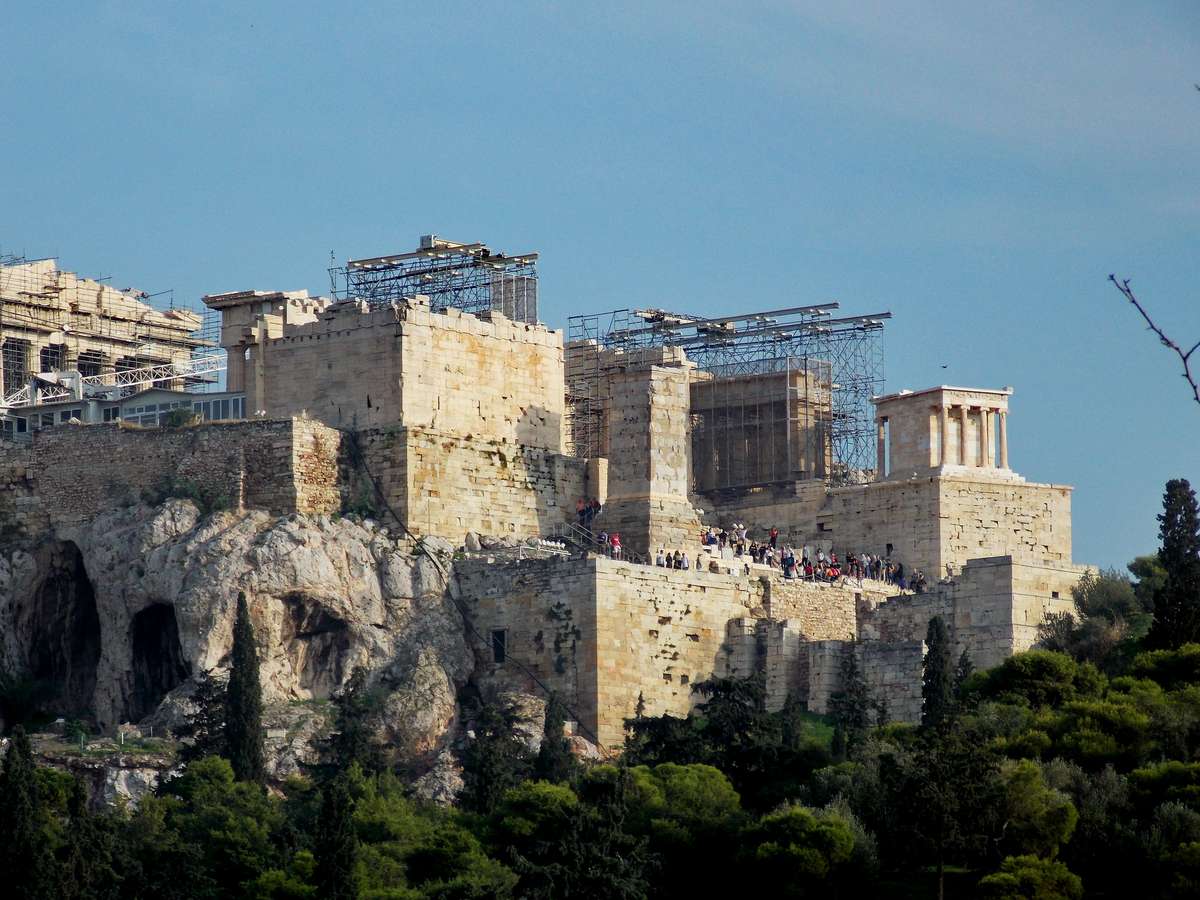 Acropolis, Propylaea (Dimitris Kamaras / flickr.com)
Acropolis, Propylaea (Dimitris Kamaras / flickr.com) The first thing that can be seen from the buildings of the Acropolis is the majestic gates with columns - the Propylaea.
They were built after the creation of the Parthenon. They were originally supposed to be absolutely symmetrical.
But since the temple of Nika the Wingless arose on the right side, it was necessary to make this part of the gate smaller in order to achieve harmony.
The architect Mnezikl was the author of this magnificent gate. He skillfully combined the severe Doric and sublime Ionic order in the construction. This structure was a gate with a roof that rested on columns, with 5 aisles.
On the left side there used to be an art gallery. There was a small room on the right. The gate was equipped with an ascent that had no steps so that chariots could enter.
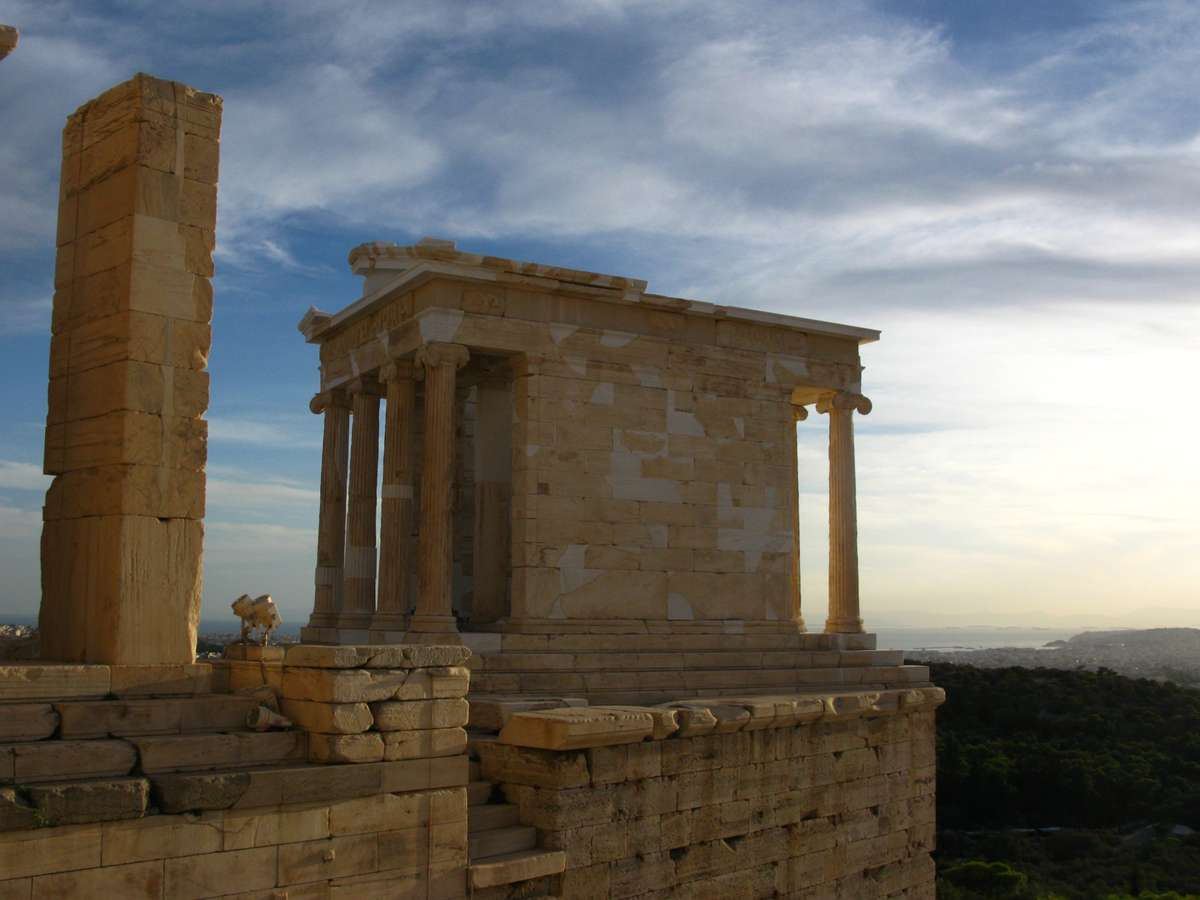 Temple of Apteros (Tilemahos Efthimiadis / flickr.com)
Temple of Apteros (Tilemahos Efthimiadis / flickr.com) The Temple of Nika the Wingless (Goddess of Victory), of course, had a statue of the goddess inside. The sculpture of Nika here has no wings, so it was conceived on purpose, since the Greeks wished that victory always remained here. The temple stands as if inviting to come inside.
The interior space is small, the walls are made of unpolished marble. Outside, the temple is decorated with a frieze with gods and battle scenes.
The reliefs of this temple were discovered in 1835. They were supposed to be located under the columns of the temple. These are relief images of the goddess Nike in various poses and scenes, but most often in profile. On one she slaughters the bull, on the other she takes off her sandals before entering the temple.
 Erechtheion (Casey And Sonja / flickr.com)
Erechtheion (Casey And Sonja / flickr.com) After passing through the gate, one could see the statue of Athena, which obscured the southern portico of Erechfeion.
The choice of the place where it was built is associated with myth. This Legend formed the basis for the entire city. Athena and Poseidon argued over which of them would become the patron saint of the city. Poseidon struck with a trident and at this point scored a source. Athena grew an olive, and locals chose her.
The Erechfeion was created in a lighter Ionic order and differs significantly from the Parthenon. In that historical monument two types of marble are combined - white and purple.
Portico Caryatids - The southern portico of Erechfeion. Here 6 sculptures of caryatids with their heads rest against the roof, hold it. The principle of symmetry and harmony prevails here, half of the sculptures rests on the left leg, half on the right. The artfully carved folds on the sculptures' clothing show slight tension. Inside the Erechfeion is complex, it has many levels. Here are the sanctuaries of the gods: Poseidon, Athena and Erechfey.
The main temple of the Acropolis of Athens - the majestic Parthenon
The ensemble of the Acropolis is crowned with an eight-column Parthenon. In terms of its grandeur, it tops the list of ancient buildings. In appearance, it is similar to the Temple of Zeus at Olympia. But he stands on a specially leveled and dumped area.
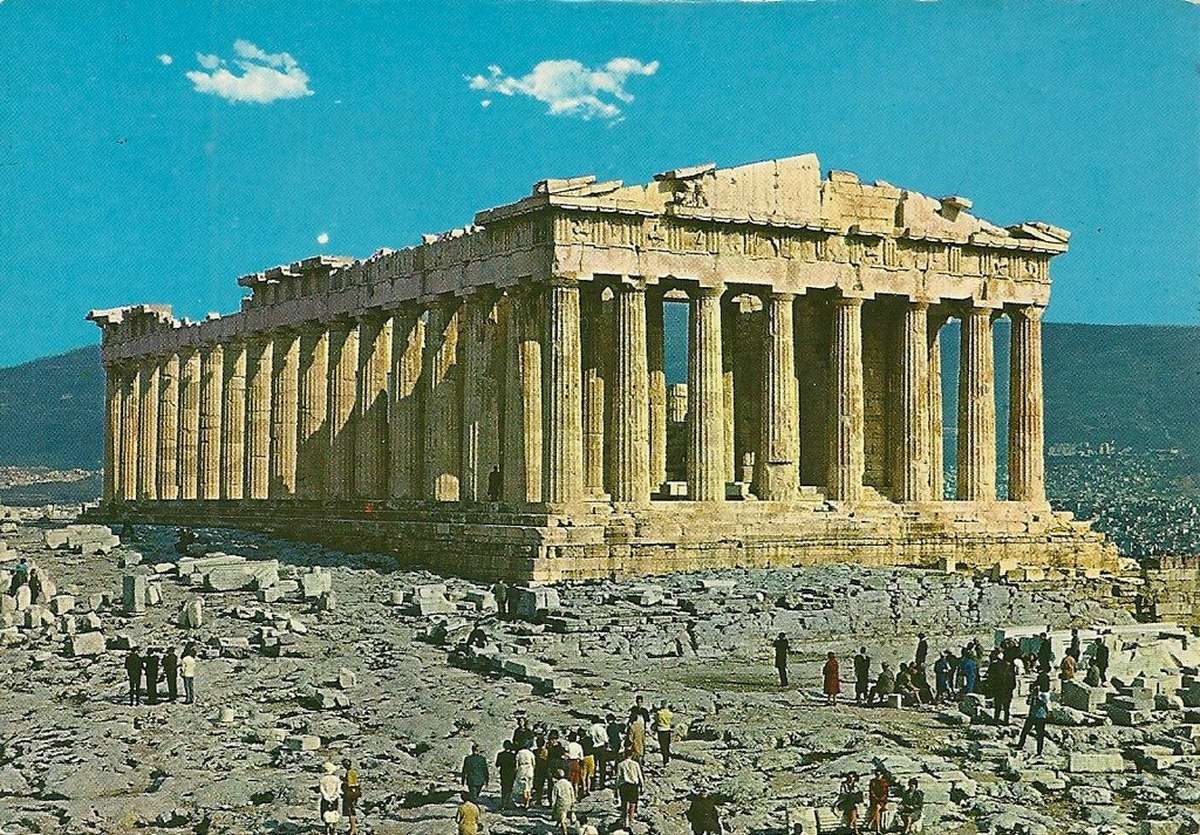 Parthenon, 1985 (Nathan Hughes Hamilton / flickr.com)
Parthenon, 1985 (Nathan Hughes Hamilton / flickr.com) During its construction, the simple archaic arrangement of buildings, such as in Olympia and Delphi, went back centuries. In ancient times, a solemn procession passed along it. It praises the greatness of man.
Of particular interest may be the Parthenon metopes, although they are poorly preserved. They represent the gods ancient greece, the series of which is completed by the goddess of the night Nyuks.
It also depicts gathering in a military campaign, parting of the soldiers, and the Trojan War. Southern metopes show a battle with mythical creatures - centaurs.
The frieze of the Parthenon depicts a solemn procession in the third year of the Olympics. It is noteworthy that the Olympic Games got this name because they were originally held in Olympia.
Here are depicted horsemen, priests with rams and bulls, young men carrying vessels. On the other side, the frieze depicts the gods surrounded by the noble people of Greece.
How to get to the Acropolis?
The Acropolis of Athens is the main attraction in Greece and naturally a place of pilgrimage for tourists.
You can take the metro to the Acropolis. The nearest station is Acropoli. In addition, you can get off at: Thissio, Syntagma Square, Monastiraki Square, Omonia Square.
Useful information for tourists
- Entrance to the entire archaeological area costs 12 euros, except Sunday (on this day you can enter free of charge).
- All museums and areas are closed on Mondays and public holidays. On other days, the visit is open from 8:00 to 19:00.
- The archaeological zone includes such attractions as the Acropolis, Temple of Zeus, Keramiko, Ancient Agora, Theater of Dionysus.
- Beforehand, it is better to familiarize yourself with the diagram on which these cultural monuments are indicated.
You can also visit New museum The Acropolis is home to many of the sculptures found here. The entrance is 5 euros, the visit is possible from 8:00 to 20:00 hours.
In ancient Greece, in addition to the Acropolis, you can visit such sights as the Temple of Zeus at Olympia and the Palace of the Grand Master in Rhodes.
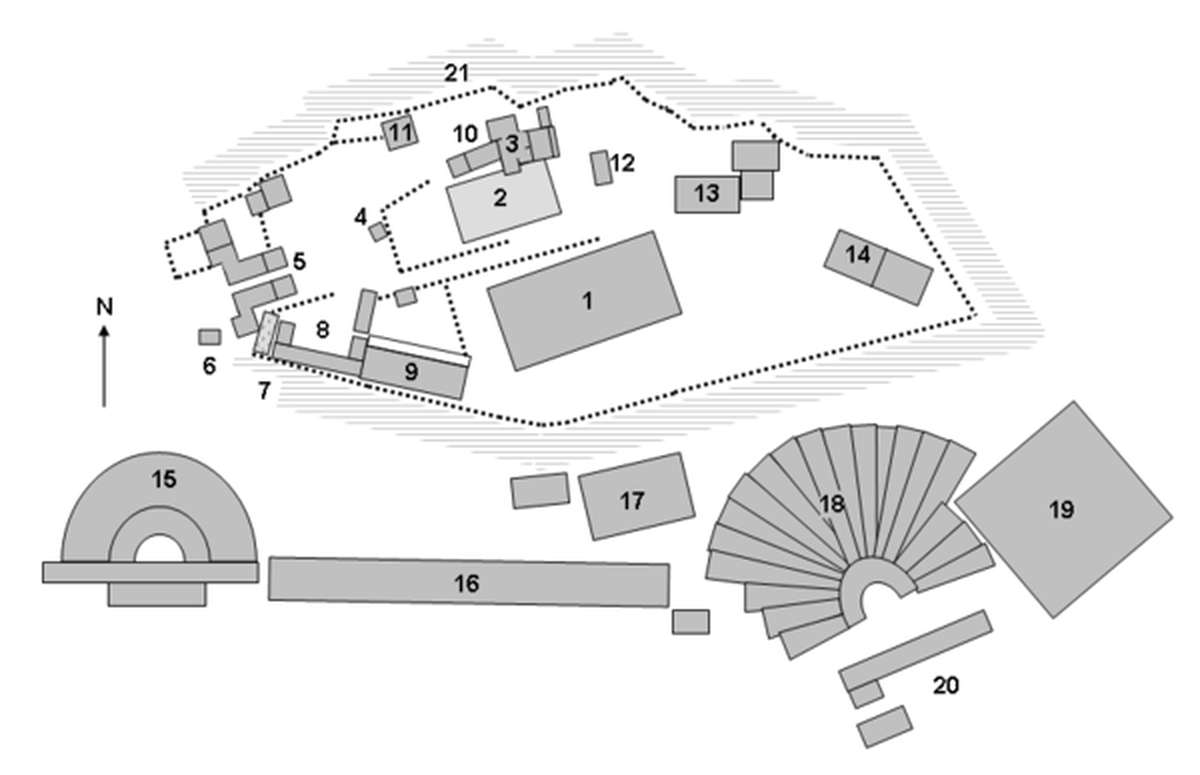 Acropolis map with signatures (© Madmedea, Wikimedia Commons)
Acropolis map with signatures (© Madmedea, Wikimedia Commons) In order to enjoy the beauty of the Athenian Acropolis, you will definitely drive through the Monastiraki area. From the northern slope of the Acropolis hill in Athens to the southwestern slope, Theorias Street stretches. On the right side at the beginning of the street there is a place from which beautiful view to the hill with all its structures. A little further, on the left side, is the Church of the Transfiguration. Starting up the slope, soon you will see on the right a small rocky hill of the Athenian Acropolis - Areopagus. In ancient times, meetings of the Athenian Supreme Court were held there.
Climbing this rock along the steps carved in stone, you need to be very careful, as they, like most of the top of the Areopagus, are very slippery. For this kind of lift, rubber-soled shoes are best. But in boots with a leather bottom, you will quickly get to the emergency room than to the flat area of the mountain. There is another ascent to the Areopagus, located not far from the already indicated one. There are metal steps on it. In the heat of the day, it is better not to climb the mountain, since you will not be able to stay at the top for a long time and in search of a shadow you will have to go back down.
Propileion became the entrance to the Athenian Acropolis. It was built in 438-432. BC. Translated from Greek, "propilaa" is an impressive front tower, which included the masses of the people. Surely the entrance to the worshiped Acropolis of Athens had to be monumental. Propileion, about which the Greeks spoke with great enthusiasm, was named the Shiny Face of the Acropolis.
However, the Acropolis of the Propyleon temple was never completed - some of its parts remained unpolished, and during the explosion at the Propyleon powder store, arranged by Turkish soldiers in 1646, the explosion at the Propileion powder warehouse was badly damaged.
On the right side of Propileion is the Acropolis Temple - Niki Apteros (Temple of the Wingless Victory). This rather elegant structure has surprisingly small dimensions - only 8.27 x 5.44 meters. In the very temple of the Athenian Acropolis there is a wooden sculpture of the goddess. According to legend, originally the goddess Victory had wings that were cut off by the Athenians so that she would remain forever in their city.
The place where the temple was erected is associated in the Athenian Acropolis with a dramatic event described in ancient mythology, - the ruler of the capital of Athens - Aegeus beheld from this place on the sea, waiting for the ships of his son Theseus, who was supposed to sail with news of important event... Theseus moved to about. Crete for the reprisal against the Minotaur and the liberation of his city from the terrible tribute, in case of his success, he had to change the black sail of mourning to the white sail of victory, but, rejoicing in his success, Crete forgot about the agreement. Aegea was misled by the black sail. The unfortunate ruler thought that his son had died and threw himself into the sea, which was then called the Aegean. The temple was destroyed during the Turkish occupation, its fragments served as material for the construction of the bastion. Fortunately, the main part of the blocks still survived, and the temple in the Athenian Acropolis was almost completely restored.
The northern side of the Athenian Acropolis is decorated with the beautiful marble Erechtheion temple, which is the finest creation of classical art. It was built on the site of the palace of the rulers of Mycenae in 419-405. BC and became a place of worship for the Athenians. It was at this place that the dispute between the two deities for patronage over the city was resolved. In order to reconcile them, the Athenians built two temples, one of which is dedicated to Athena and the other to Poseidon, both temples being under the same roof. This building is called the Erechtheion. Eastern part The temple was dedicated to Athena - the oldest statue of the goddess is kept here, which, according to the Athenians, fell from heaven. The Temple of Poseidon in the Acropolis is 12 steps lower. In the floor of this temple, in a place where there is no tiled flooring, three holes are visible, which are considered traces of the trident of Poseidon. Exactly in this place on the roof of the temple, you can see the hole from the handle of the trident, which was made when it was lifted, during the impact. Apparently, the ancient Greeks were not at all embarrassed by the temporal paradox.

Of greatest interest in the Erechtheion is the Portico of the Daughters, which consists of six sculptures of the most beautiful girls, which, acting as columns, support the roof of the temple. In Byzantine times they were called Caryatids, that is, women from a small town named Caria, which was famous for its exceptional beauty. V early XIX century one of the Caryatids, along with pediments and friezes, with the permission of the Turkish government, was taken to England by the Ambassador of Constantinople, Lord Elgin. The Athenians were so excited by Elgin's act that a legend was soon invented about the night crying of the five Daughters who remained in the temple, about their stolen sister. Lord Byron wrote the poem "The Curse of Athens", dedicated to the looters of these priceless treasures. The British Museum to this day keeps the famous Elgin marbles, a copy was placed in the place where the statue stood.
On the hill of the Areopagus or the Supreme Court, court hearings were held during the time of ancient Athens. At the foot of the mountain are the burials of the Mycenaean kings of the era of their reign in Athens. They are long tunnels that go into the thickness of the stone. To the right of the stairs is a rock on which the sermons and words of the Apostle Paul, preaching here in 50 AD, are carved. Nearby is the tomb of St. Dionysius the Areopagite - the first convert by Paul.
Climbing the Areopagus, you can enjoy plenty of great view Syntagma squares, Omonia, Monastiraki, Plaka, Ancient Agora and most of Athens. This is an unforgettable sight. A lot of people come here at sunset to admire the city in the light of the setting sun. At night, here you can meet many couples in love admiring the glowing city and each other.
Without his sacred mountain The Acropolis of Athens would not be Athens. Standing in the middle of a modern, car-free shopping street gives you a view of the Acropolis of Athens. Sitting on one of the warm summer evenings on a cozy terrace at a table under open air, you will see the Athenian Acropolis illuminated by lights again. As intrusive as it may sound, you must visit the Athenian Acropolis, which is the soul and heart of Athens! It is best to choose the morning hours for this, when there is still no intense heat, and climbing steep streets will replace a full morning exercise.
Temples of the Acropolis: Arreforio, Erechtheion, Parthenon, Temple of Athena-Victory, Propylaea and other beautiful ancient structures will take you to the times of the Greek Gods, Pericles, Ictinus, Phidias, and the builders and architects of this unsurpassed temple complex... Unfortunately, it is currently impossible to visit the Acropolis Museum, located behind the Parthenon, since its entire exposition has been transferred to the ultra-modern New Acropolis Museum.
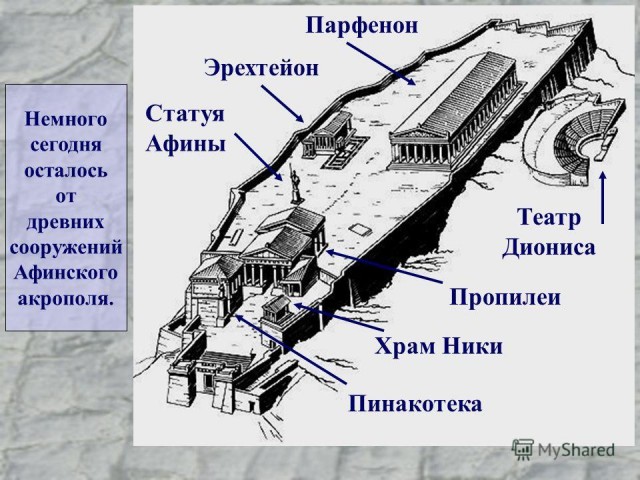
Many sources contain various translations of the word "Acropolis", among which there are even the most incredible and funny ones. In fact, in ancient times there were only two translations: "city on a hill" and "edge of the city". Currently, the second version of the translation has become more widespread.
The sacred mountain has finally become available for people with physical disabilities! In accordance with the requirements of the International Olympic Acropolis Committee and the European Union, permits of the Greek Ministry of Culture, the Central Council for Archeology and the order of the minister, you can climb the hill using an elevator built above the Kanellopoulos Museum on the northern slope.
To the north of the main entrance to the Acropolis of Athens, there is a special entrance through which a person in a wheelchair and his companion can reach the elevator. A special moving platform lifts from the sidewalk to the elevator level. At the very top, from the elevator to the observation zone located in the north-west of the Erechtheion, there is a platform and an inclined path. A paved path from the Erechtheion to the northwestern corner of the Parthenon leads to a place where you can admire the eastern façade of the Propylaea. From the northeastern corner of the beautiful Parthenon, the path turns to the Athenian Acropolis Museum, where the eastern side of the Parthenon and the ruins of Rome and the Temple of Augustus are clearly visible. In the Acropolis of Athens, take a small vertical elevator down to the entrance level of the Acropolis Museum, which is currently closed.
In order for people in wheelchairs to avoid the usual crowds of the day, it is better to plan your day in such a way as to see the Athenian Acropolis from 8 to 10 o'clock in the morning and from 13 to 17 o'clock in the afternoon. Do not forget that it is very hot at the top of the hill on a summer afternoon!




